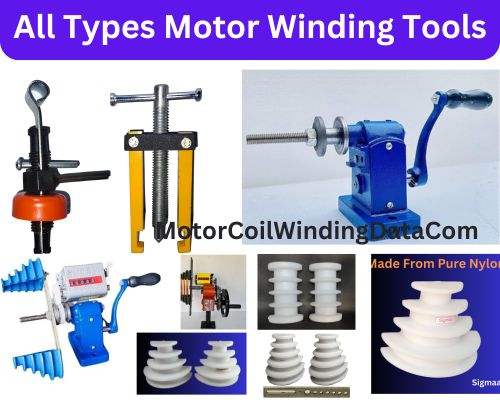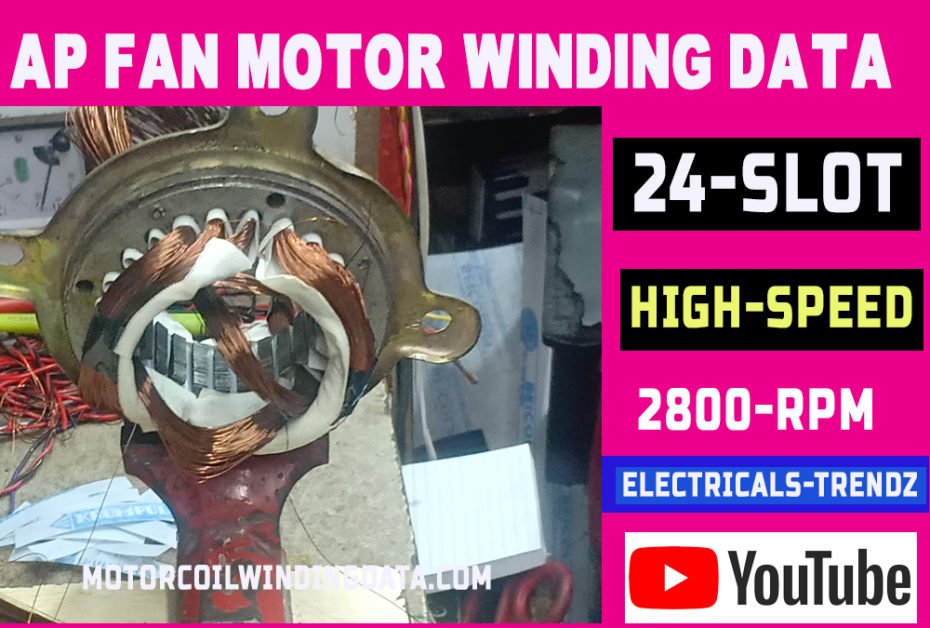Topics Cover In This Post
6+6 Coil High-Speed Ceiling Fan Winding Data
6+6 Coil High-Speed Ceiling fans are an essential fixture in homes, offices, and industrial spaces, providing much-needed ventilation and cooling. One crucial aspect of ceiling fan design is the winding data, which determines the performance and efficiency of the fan motor.
In this article, we’ll explore the intricacies of 6+6 coil high-speed ceiling fan winding data, its benefits, calculation methods, and applications.
What is 6+6 Coil High-Speed Ceiling Fan Winding?

6+6 coil ceiling fan winding refers to a specific configuration where each pole of the motor has six coils. This configuration is optimized for high-speed ceiling fans and offers several advantages over traditional winding setups. By increasing the number of coils, 6+6 coil winding enhances the motor’s efficiency and performance, resulting in smoother operation and reduced energy consumption.
6+6 Coil High-Speed Ceiling Fan Winding Data.
इस पोस्ट में हमने बताया है के आप कैसे एक सीलिंग फैन को हाथ से वाते वाइंडिंग करके उसको एक हाई स्पीड सीलिंग फैन बना सकते है। इस सीलिंग फैन के 960 आरपीएम होंगे,और यह पंखा 6 पोल में रिवाइंड होगा ,आप इसमें 7 नंबर का वाइट पप्पेर जा क्रेम्पले का वाइट शीट पेपर जा ग्रीन पेपर 10 नंबर का दाल सकते है. हर मोटर की तरह इस मोटर को बे वाइंडिंग करने के बाद वार्निश करना बहुत जरुरी होता है.
- Core Length – 5 Soot
- Slot – 12+12
- Volts – 220
- Capacitor – 3.15 mfd
- Winding Wire = Copper
- RPM – 960
- Bearing Size 6202+6201
- Insulation Paper Size – 7 Number
- Total Running Coils – 6 PC
- Total Starting Coils – 6 PC
- Winding Pole – 6 POLE {High Speed } 960-RPM
- Running Pitch – 1-4
- Running Coil Winding Turns = 550 Turn
- Running Standard wire GAUZE = 35 (Copper-wire)
- Winding Wire Type = Copper Wire
- Starting Winding Coil Pitch – 1-4
- Starting Turns = 660
- Starting Standard Wire GAUZE = 36 Number (COPPER-WIRE)
- रनिंग पिच – 1-4
- रनिंग कॉइल वाइंडिंग टर्न = 550 टर्न
- रनिंग स्टैंडर्ड वायर धुंध = 35 (कॉपर-वायर)
- घुमावदार तार प्रकार = तांबा तार
- स्टार्टिंग वाइंडिंग कॉइल पिच शुरू करें -1-4
- स्टार्टिंग टर्न = 660
- तार नंबर = 36 नंबर (कॉपर-वायर)
| Volts | 220v Ac Supply |
| Ceiling Fan Stator Slots | 12+12 Slots |
| Rpm | 960 ( 6 Pole ) |
| Running Coil Turns ( Up Side Coils ) | 550 Turns |
| Running Winding Wire Number | 35 Number ( Copper Wire ) |
| Copyrights | Motorcoilwindingdata.com |
| Starting Coil Turns ( Bottom Side ) | 660 Turns |
| Starting Winding Wire Number | 36 Number ( Copper Wire ) |
| Winding Wire Type | Copper Wire |
| Insulation Number | 7 No Pvc Paper |
All Types of Motor Winding Tools Check Out Here:-

How to Calculate 6+6 Coil High-Speed Ceiling Fan Winding Data
Calculating the winding data for a 6+6 coil ceiling fan configuration involves several steps and considerations. Firstly, the desired specifications for the wire gauge, number of turns, coil diameter, and coil pitch must be determined based on the fan’s intended application and performance requirements.
Once these parameters are established, specialized tools and formulas can be used to calculate the exact winding data needed for the motor.
Which winding is better for ceiling fans? Copper Vs Aluminum.
When comparing copper and aluminum windings for ceiling fans, copper winding is generally considered superior in terms of performance and durability.
Copper winding offers several advantages over aluminum winding. Firstly, copper has a higher electrical conductivity than aluminum, which means it can carry electrical currents more efficiently. This results in lower energy losses and higher motor efficiency, translating to reduced energy consumption and lower operating costs for the user.
All Ceiling Fan Winding Data

Additionally, copper wire is more resistant to heat and corrosion compared to aluminum. This increased durability ensures a longer lifespan for the winding, leading to fewer maintenance issues and greater reliability over time.
While aluminum winding may be less expensive initially due to the lower cost of aluminum compared to copper, the long-term benefits of copper winding often outweigh the initial cost savings. Copper winding provides superior performance and reliability, making it the preferred choice for ceiling fan manufacturers and consumers alike.
6+6 Coil High-Speed Ceiling Fan Winding Video.
7 Top High Speed Ceiling Fans In India.
- ✅POWERFUL AIRFLOW (850 RPM) – Low-density helps make this silent ceiling fan lightweight to provide a superior air…
- ✅EXCLUSIVE HIGH FLOW TECHNOLOGY AND AERODYNAMICALLY DESIGNED BLADES – Heavy crc stamping to enhance the life of the…
- ✅600 MM BLADES SWEEP – Designed with 600 mm blades to offer an airflow that ensures a wider conical spread of breeze…
- ✅BODY DESIGN/FEATURE : Rust Proof Powder Coated Body and Wide Blade set. Also, comes with the glossy finish and dust…
- ✅AERO DYNAMICALLY DESIGNED BLADES – The Aerodynamic ceiling fan blades that are designed to optimize air flow and…
- ✅ 【Product】: Bajaj Frore EE 1200 mm Brown Ceiling Fan with 3 blades; Series: Frore
- ✅ 【Sweep Size】: 1200 mm; Colour: Brown; Power: 52 Watts; RPM: 390
- ✅ 【Energy Efficient With BEE 1-Star Rated】: Low Power Consumption fan designed to save on your electricity bill….
- ✅ 【Enhanced Aesthetics & 100% Copper Motor】: High speed ceiling fan with new shades and ribbed blades for…
- ✅ 【Product Warranty】: 2-year product warranty. Domestic Warranty only. Terms & Conditions Applied
- Super Energy Efficient Motor: Elegant Design Comprises the energy efficient technology from Longway. Motor comes with ZZ…
- Body Design/Features: Rust Proof Powder Coated Body and Wide Blade set. Also, comes with the glossy finish and dust…
- Speed Size Features: 1200 mm Wide Blade Set, 400 RPM High Speed, Air delivery 230 CMM, Number of Speed setting – 5….
- Package Content: Ceiling Fan including Fan Motor, Down Rod, Shackle Assembly Kit, Canopy Set (Top and Down), Blades Set,…
- Warranty Period: 5 Years Limited Domestic Brand Warranty. Enjoy the hassle free warranty by Longway on your product.
- ✅POWERFUL AIRFLOW (390 RPM) – Low-density helps make this silent ceiling fan lightweight to provide a superior air…
- ✅1200 MM BLADES SWEEP – Designed with 1200 mm blades to offer an airflow that ensures a wider conical spread of breeze…
- ✅DOUBLE BALL BAERING – The powerful motor come with double ball bearing which makes sure that the fan runs smoothly…
- ✅EXCLUSIVE WITH HIGH FLOW TECHNOLOGY – Heavy crc stamping to enhance the life of the fan. This fan is also…
- ✅AERO DYNAMICALLY DESIGNED BLADES – The Aerodynamic ceiling fan blades that are designed to optimize air flow and…
- Product Details: Crompton Highspeed Toro is a premium decorative ceiling fan, and its design is inspired by modern…
- Performance: 1-Star rated fan which is equipped with a powerful motor that gives a 370 RPM speed with superior air…
- Anti Dust Fan: It is an Anti-Dust fan which attracts ~50% less dust than regular fans (Under ideal test conditions)
- Durability: It is Equipped with Active Power Technology and double ball bearings which makes its motor super-efficient…
- Color Variants: It is available in super looking shades – Magic Brown, Silver Magic White, Birken Effect, Warm Grey
- ✅ 【Sweep】 : 600mm, Power : 66W, Air Delivery : 110CMM
- ✅ 【High Speed】 : Provides 870 RPM ; Rated Power (Watts): 66 ; Speed Settings: 3
- ✅ 【Double Ball Bearing】 : Increases load bearing capacity and durability,
- ✅ 【Quick-start High Torque Motor】 : Provides instant comfort by achieving high performance quickly
- ✅ 【Warranty】: 2 years on product, High speed fan with sleek and modern looks, Automatic winding to ensure…
- ✅POWERFUL AIRFLOW (650 RPM) – Low-density helps make this silent ceiling fan lightweight to provide a superior air…
- ✅900 MM BLADES SWEEP – Designed with 900 mm blades to offer an airflow that ensures a wider conical spread of breeze…
- ✅DOUBLE BALL BAERING – The powerful motor come with double ball bearing which makes sure that the fan runs smoothly…
- ✅EXCLUSIVE WITH HIGH FLOW TECHNOLOGY – Heavy crc stamping to enhance the life of the fan. This fan is also…
- ✅AERO DYNAMICALLY DESIGNED BLADES – The Aerodynamic ceiling fan blades that are designed to optimize air flow and…
Faq:-
Which winding is better for ceiling fans?
When comparing copper and aluminum windings for ceiling fans, copper winding is generally considered superior in terms of performance and durability.
Copper winding offers several advantages over aluminum winding.
Firstly, copper has a higher electrical conductivity than aluminum, which means it can carry electrical currents more efficiently. This results in lower energy losses and higher motor efficiency, which in turn reduces energy consumption and lower operating costs for the user.
What is the main winding of a ceiling fan?
The main winding of a ceiling fan refers to the primary coil or set of coils within the fan motor. This winding is responsible for generating the magnetic field necessary for the motor to operate.
It interacts with the rotor (the rotating part of the motor) to produce the rotational motion that drives the fan blades.
The main winding typically consists of copper wire wound around a core, although variations may exist depending on the specific motor design.
It is essential to provide the initial torque needed to start the fan and maintain a consistent speed during operation.
How many windings are in a ceiling fan?
A typical ceiling fan usually has two windings: the main winding and the auxiliary winding.
Which is better, a 1200mm or a 1400mm fan?
The choice between a 1200mm and a 1400mm fan depends on the size of the room and personal preferences. Generally, a 1400mm fan is better suited for larger rooms as it can cover a wider area and provide better airflow.
On the other hand, a 1200mm fan is suitable for smaller to medium-sized rooms. It’s essential to consider the room size and ceiling height when deciding between the two sizes to ensure optimal airflow and comfort.










